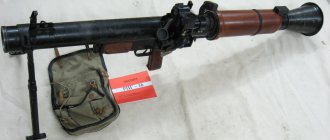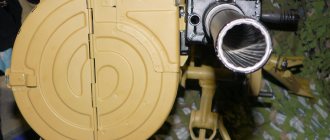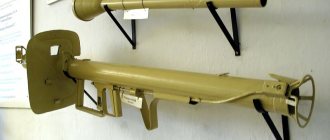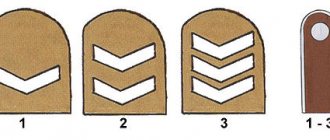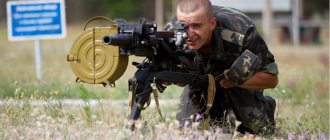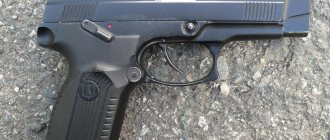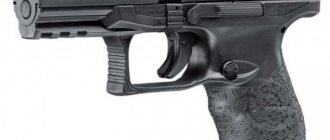The first months of fighting on the Eastern Front showed a significant advantage of heavy Soviet and T-34 tanks over German tanks and anti-tank artillery of the Wehrmacht. The German Pak 35/36 anti-tank gun could not effectively fight Soviet combat vehicles equipped with ballistic armor. Due to its low effectiveness, German soldiers called the weapon a “beater” or “cracker,” and German military leaders later called the confrontation between the T-34 and Pak 35/36 “a dramatic chapter in the history of the German infantry.”
The Germans had 88mm anti-aircraft guns, which they used successfully against Soviet tanks, but they were not very useful. These guns were bulky, expensive, there were few of them and they could not always cover the infantry from the advance of tanks. The Germans tried to solve the problem by using special ammunition, sub-caliber and cumulative shells, but this only partially resolved the issue. The worst thing was different: in close combat with enemy tanks, German soldiers remained practically unarmed, since it is very difficult to destroy a formidable combat vehicle with a grenade.
It was necessary to look for another solution, and German designers found it: at the beginning of 1943, the first 500 Faustpatrons entered service with the Wehrmacht. This weapon was simple and cheap, but at the same time highly effective. His work was based on the dynamo-reactive principle. During the war years, German industry produced 8,254,300 units of various modifications of these weapons.
The history of the creation of Faustpatron
"Faustpatron" (Panzerfaust or Faustpatrone) was developed by HASAG (Hugo Schneider AG) under the direction of Dr. Heinrich Langweiler. He was faced with the task of creating a simple and effective means of combating enemy tanks at short distances. It is believed that the Germans were inspired to create the Panzerfaust by their acquaintance with the American bazooka.
However, there are significant differences between the bazooka and the Faustpatrone: the bazooka is essentially a man-portable rocket launcher, while the Faustpatron is more like a recoilless rifle. The Panzerfaust grenade launcher was designed so that any infantryman could use it after a short instruction. The American bazooka had a permanent and well-trained crew.
During the war years, the Wehrmacht received several modifications of the Panzerfaust; “Faustpatron” is rather a collective name for all types of these weapons.
The first Faustpatron did not have a sight, its pointed front often ricocheted off tank armor, and the weight of the explosive in the warhead was insufficient. The manufacturer took these shortcomings into account, and very quickly the Wehrmacht adopted a modernized version of the weapon - the Panzerfaust. In this modification, the size and weight of the head of the grenade was increased, its front part was made in the form of a flat platform, and the weight of the explosive increased. All this led to an increase in the armor penetration of weapons.
The “Faustpatron” received exactly the classic appearance familiar to us from war films and turned into a simple and deadly weapon that leaves virtually no chance for any tank.
A distinctive feature of the Panzerfaust was its ease of production and low cost.
With a grenade weight of 3.25 kg, the Faustpatron could penetrate the armor of any Soviet tank. The effectiveness of this weapon is evidenced by the following figures: from January to April 1944, the Germans, using the Faustpatron, destroyed more than 250 Soviet tanks.
This weapon had a greater resource for further modernization, which the developers took advantage of already at the beginning of 1944. The changes that were made to the Faustpatron affected almost all the characteristics of this weapon. The new modification was called Panzerfaust 60. The range of aimed fire increased to 60 meters, the combat qualities of the weapon increased, and its production was simplified. Main changes:
- Increasing the caliber of the launch tube to 50 mm, as well as increasing the thickness of its walls. This made it possible to increase the weight of gunpowder in the propellant charge, thereby increasing the speed and range of the grenade.
- The grenade was connected to the stem thanks to a special latch, rather than a thread, which simplified the loading process and made it possible to install a front sight.
- The push-button type impact mechanism was replaced with a simpler and more reliable lever type. The igniter primer was replaced.
- Panzerfaust 60 received a more advanced sight.
- The weight of the modernized weapon increased to 6.25 kg.
The use of Faustpatrons in vast areas of the USSR was less effective than in densely populated Eastern Europe due to the short firing range of the grenade launcher. German industry rapidly increased production of Panzerfaust: if in April 1944 the Wehrmacht received 100 thousand units of this weapon, then in November of the same year this figure amounted to 1.084 million units. It is for these reasons that most tanks were knocked out with the help of Faustpatrons at the final stage of the war. At the end of the war, Panzerfaust became the main anti-tank weapon of the Wehrmacht, SS troops and militia units. German troops on the front line had several units of such weapons per soldier, which significantly strengthened the anti-tank defense and increased the losses of Soviet tanks.
The need for these weapons among the troops was so great that the military, on its own initiative, set up the collection of disposable Faustpatron launch tubes to send them to factories for secondary equipment.
However, Soviet soldiers also gained experience in fighting grenade launchers. Each tank was defended by a whole group of infantrymen located at a distance of 100-200 meters from it.
German designers continued to work on improving the grenade launcher. At the end of 1944, a new modification of the Panzerfaust appeared, which could fire at one hundred meters. In addition, the armor-piercing ability of the new grenade launcher and its firing accuracy have increased. The Panzerfaust-100 became a truly formidable opponent for any Allied tank, including the heaviest vehicles.
To reduce the number of losses from the new German weapons, Soviet tank crews shielded their vehicles, changed tactics, and tried to avoid close combat.
At the very end of the war, the Teutonic gloomy genius released another Panzerfaust model, which had a firing range of up to 150 meters and could be used several times. To increase the firing range, the aerodynamic characteristics of the grenade were improved by changing its shape and reducing its diameter. Stabilizers and special grooves ensured stable flight of the grenade. The maximum flight range was 300 meters, and the effective firing distance was 150 meters. A steel jacket with a notch could be put on the body of the grenade, which, when detonated, produced a large number of fragments. So the new grenade launcher became effective not only against enemy tanks, but also against its manpower.
However, the HASAG company managed to produce only 500 copies of the new grenade launcher, and in April Leipzig was captured by the Americans. The Germans were also working on the creation of a “Faustpatron” with an aiming range of 250 meters, which was very similar to modern grenade launchers, but they were unable to implement these plans; Germany capitulated.
“Faustpatrons” caused enormous damage to Soviet troops during the Battle of Berlin: in total, more than 800 Soviet tanks and self-propelled guns were destroyed in this battle, most of which were hit by grenade launchers.
The Faustpatron can be called one of the most effective weapons of the German army. In terms of price-performance ratio, it had no equal. By creating the Panzerfaust, the Germans practically opened a new direction in the arms business.
"Armor Pliers"
A smaller copy of the Panzerfaust was the Panzerknacke (Armor Tongs) grenade launcher. They equipped saboteurs with it, and the Germans planned to eliminate the leaders of the countries of the anti-Hitler coalition with these weapons.
On a moonless September night in 1944, a German transport plane landed on a field in the Smolensk region. A motorcycle was rolled out of it along a retractable ramp, on which two passengers - a man and a woman in the uniform of Soviet officers - left the landing site, driving towards Moscow. At dawn they were stopped to check their documents, which turned out to be in order. But the NKVD officer drew attention to the officer’s clean uniform - after all, there had been heavy rain the night before. The suspicious couple was detained and, after checking, handed over to SMERSH. These were saboteurs Politov (aka Tavrin) and Shilova, whose training was carried out by Otto Skorzeny himself. In addition to a set of false documents, the “major” even had fake clippings from the newspapers “Pravda” and “Izvestia” with essays about heroic deeds, decrees on awards and a portrait of Major Tavrin. But the most interesting thing was in Shilova’s suitcase: a compact magnetic mine with a radio transmitter for remote detonation and a compact Panzerknakke rocket launcher.
The length of the “Armor Tongs” was 20 cm, and the launch tube had a diameter of 5 cm. A rocket was put on the tube, which had a range of thirty meters and penetrated armor 30 mm thick. The Panzerknakke was attached to the shooter's forearm using leather straps. In order to carry a grenade launcher secretly, Politov was sewn a leather coat with an extended right sleeve. The grenade was launched by pressing a button on the wrist of the left hand - the contacts closed, and the current from the battery hidden in the belt initiated the Panzerknakke fuse. This “miracle weapon” was intended to kill Stalin while traveling in an armored car.
Description of Panzerfaust
The Faustpatron was a disposable anti-tank grenade launcher that used the same operating principle as recoilless rifles. Its structure was very simple. The grenade did not have its own jet engine; the propellant charge was placed in the launch tube of the weapon and fired the grenade. After it was ignited, the powder gases pushed the grenade forward and burst out of the barrel back, compensating for the recoil.
The trigger mechanism and sighting devices were installed on the launch tube. On later modifications of the faustpatron, the grenade received four folding stabilizers. The grenade charge consisted of a mixture of tol and hexogen.
The sighting devices consisted of a folding bar and the edge of the grenade shell. In the stowed position, the aiming bar was attached to the eye of the grenade with a pin and blocked the trigger mechanism.
The top of the sighting bar and the front sight were painted with luminescent paint for ease of aiming in the dark.
To fire a shot, the grenade launcher was placed under the arm, aimed and the trigger was pressed. The shooter must be careful, since the jet of powder gases from the rear of the weapon reached 4 meters and could, reflected from any obstacles, concuss the shooter. Therefore, the Panzerfaust could not be fired from enclosed spaces.
After the shot, the grenade fuse was cocked and went off when it encountered any obstacle.
Panzerfausts are the last hope of Germany
Soviet commanders are reproached for mediocrity and bloodthirstiness: after all, having sent their troops straight to the streets of Berlin, they actually handed them over to be torn apart by the deadly “Faustniks,” which resulted in “two burned Soviet tank armies.” Was this really so? Fortunately, no. The real picture of historical events differs significantly from these worn-out mythological cliches... The first anti-tank grenade launchers - Faustpatrons (or, as they were also called, “Panzerfausts”) - began to be produced by the Germans back in 1943, but until a certain point they did not cause much concern to the Soviet troops. However, at the beginning of 1945, when the fighting moved to Germany itself, the effectiveness of the use of faust cartridges increased significantly. The reduction of the front line (and, consequently, an increase in the density of troops), and the improvement of the technical parameters of the grenade launcher itself, and certain moral incentives played a role - after all, the war was already taking place directly on the territory of the “Fatherland”.
Tactical and technical characteristics of Faustpatron
| Option | Weight, kg | Head caliber, mm | Effective firing range, m | Armor penetration, mm |
| Faustpatrone-30 | 2,7-3,2 | 100 | 30 | 140 |
| Panzerfaust-30 | 6,9 | 149 | 30 | 200 |
| Panzerfaust-60 | 8,5 | 149 | 60 | 200 |
| Panzerfaust-100 | 9,4 | 149 | 100 | 200 |
| Panzerfaust-150 | 6,5 | 106 | 150 | 280—320 |
Pensioners and schoolchildren against the T-34? No chance…
This is what the commander of the 2nd Guards Tank Army, General S.I., wrote about this. Bogdanov: “About the Faustpatron. I cannot agree that the Faustpatron was an obstacle to tank forces. Why? The Faustpatron was in the hands of an untrained, morally, physically and militarily unprepared soldier of the German Volkssturm army, and therefore it was not such a formidable weapon for our unsurpassed Soviet T-34 tank. During the offensive, I spoke very seriously with my corps commanders, brigade commanders, and personnel and found out that the Faustpatron was a bogeyman, which sometimes groups or individual tanks were afraid of, but I repeat that in the Berlin operation the Faustpatron was not such a terrible weapon as some imagine " One cannot but agree with Bogdanov’s assessment. Here, for example, is what the 42nd Volkssturm Battalion was like - a typical militia unit that fought on the streets of Berlin. It consisted of 400 people, but it had only 180 Danish rifles, 4 machine guns and 100 cartridges. Not a single member of the battalion had any training in even firing a machine gun, let alone fighting tanks! It is clear that this “powerful” unit could not pose any serious threat. It is not surprising that the Volkssturmists often simply ran away at the sight of tanks.
Notes
- And this is only in theory. In Norway and Flanders, even Pz.IIs (with armor no more than 15 mm) were not reliably hit by Boys. Epic fail.
| [ + ] Bullet is a fool, Panzerfaust is great! | |||||||||||||||||||||||
| |||||||||||||||||||||||
| [卐 ] | |||||||||||||
| |||||||||||||
Only artillery “resolves issues”
What was the final damage from the fire of Faustpatrons on the streets of Berlin? After the end of the operation, the damaged Soviet tanks were inspected (During the war, this was a mandatory procedure: reports on combat damage were sent to the Main Armored Directorate of the Red Army. Subsequently, this kind of statistics was used in the development of new equipment). The result of the examination leaves no stone unturned in the legend of the “terrible” cartridge fausts. So, for example, out of 75 destroyed tanks and self-propelled artillery installations of the 1st Guards Tank Army, 67 vehicles were killed by artillery fire, 2 vehicles were killed by air strikes, and 6 vehicles were killed by Faust cartridges. In the 2nd Guards Tank Army, the share of losses from Panzerfausts was slightly higher - 17 vehicles. Agree that two dozen destroyed tanks are in no way comparable to the “two tank armies burned by the Faustians.” To sum it up, we can say that the idea of the powerful Faustpatrons is greatly exaggerated. In fact, faustpatrons (like the Soviet anti-tank rifles of the 1941 model) were, as they say, “weapons of despair.” The damage from the fire of these grenade launchers amounted to a few percent of the total losses of Soviet armored vehicles. The main threat to tanks for both warring sides throughout the war was artillery.

